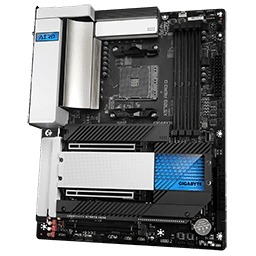Gigabyte X570S AERO G Review
Source: Tech Power Up added 21st Aug 2022 Packaging & Contents »
Introduction
In today’s review, we will be taking an up close look at Gigabyte’s X570S AERO G motherboard for the AMD based systems. This also may very well be the last chipset for the long standing AMD AM4 socket. We were first introduced to the Ryzen Zen CPU in 2017. This was quickly followed up by Zen+ based processor. Next, with the Zen 2 launch, using the same X naming convention as the follow-up to X470 came a new X570 chipset to extend the AM4 socket lifespan once again. Its largest change overall came in the form of a new x4 PCIE 4.0 uplink to the CPU. This upgrade allowed for more USB ports, M.2 sockets, and PCIE slots using the X570 chipset.
After the highly successful B550 chipset launch in 2020, marketed and priced to be more budget friendly. Waiting for the perfect moment to upgrade can pay off, especially as prices decrease and bugs are worked out over multiple revisions. AMD X570 (S) is the latest revision from AMD this the AM4 socket. “S” being for silent as the chipset fan has been removed.
AMD’s Computex 2022 press conference revealed the company’s plans for the new AM5 socket and new Zen 4 processors. In additional news, the company has not ruled out extended support for its current AM4 socket. With strong sales and a competitive advantage in gaming and production workflows, those looking for a mature platform will find AM4 something that shouldn’t be written off just yet. With AMD long-term support the AM4 socket, motherboard manufacturers have an opportunity to refresh the X570 lineup yet again with new features, including Wi-FI 6E, USB 3.2 connectivity, Thunderbolt 4, and higher supported memory frequencies that just weren’t available three years ago.
Gigabyte uses the AERO naming convention to market it towards content creators. These can be strictly for work or a bit of gaming on the side as well. The AERO branded motherboards coincide with other content creation oriented products like Vision and Designare that are marketed towards the same targeted audience. Some of which have been discontinued due to being only created for a certain chipset that often overlap in features and suggested price points. The X570S AERO G is designed to be used in a work computer with an emphasis on increase storage options, lots of external connectivity points and a beefy power delivery system for maximum uptime. Understanding that this motherboards focus on the workforce, we will take a closer look at the features that will help aid in that viewpoint throughout this review. Now let’s get started.
Specifications
| Specifications | |
|---|---|
| CPU Support: | AMD Ryzen 5000 Series, 5000 G-Series, 4000 G-Series, 3000 Series, 3000 G-Series, 2000 Series and 2000 G-Series desktop processors |
| Power Design: | CPU Power: 12-phase SoC Power: 2-phase |
| Chipset: | AMD X570S |
| Integrated Graphics: | Dependent on installed CPU 1x USB Type-C® port, supporting USB Type-C 1x HDMI port, supporting a maximum resolution of 4096×2160@60 Hz |
| Memory: | 4x DIMM 128GB dual-channel DDR4-5400+ (OC) |
| BIOS: | UEFI BIOS 256 Mbit Flash |
| Expansion Slots: | 1x PCIe Gen4 x16 Slot 1x PCIe Gen4 x16 Slot (wired for x8) 1x PCIe Gen4 x16 Slot (x4 PCIe from X570S) |
| Storage: | 6x SATA 6 Gb/s ports 2x M.2 Sockets (PCIe Gen4 x4) 2x M.2 Socket (SATA/PCIe Gen4 x4) |
| Networking: | 1x Intel 2.5 Gb Ethernet 1x Intel Wi-Fi 6 AX200 |
| Rear Ports: | 2x USB 2.0/1.1 ports 2x SMA antenna connectors (2T2R) 1x HDMI port 1x DisplayPort In port 1x USB Type-C® port, with USB 3.2 Gen 2×2 support 1x USB Type-C® port, with USB 3.2 Gen 1 support 4x USB 3.2 Gen 2 Type-A ports (red) 2x USB 3.2 Gen 1 ports 1x RJ-45 port 1x optical S/PDIF Out connector 5x audio jacks |
| Audio: | 1x Realtek AL1220-VB Codec |
| Fan Headers: | 8x 4-pin |
| Form Factor: | ATX Form Factor: 12.0 x 9.6 in.; 30.5 x 24.4 cm |
| Exclusive Features: |
|
Sign in / Register
- Noctua NH-D12L Review – Perfect for Mini-ITX
- Intel Arc A380 Review – Runs Fine on AMD Ryzen
- ASUS ROG Maximus Z690 Extreme Glacial Review
- Marvel’s Spider-Man Remastered: DLAA vs. DLSS vs. FSR 2.0 Comparison Review
- Corsair Dominator Platinum RGB DDR5-6600 CL32 2x 16 GB Review
- Upcoming Hardware Launches 2022 (Updated Jul 2022)
- Truthear x Crinacle ZERO In-Ear Monitors Review – Two Dynamic Drivers, One Harman Tuning!
- Lofree 1% Dual Mode Transparent Mechanical Keyboard Review
- Sonos Ray Review
- Gigabyte X570S AERO G Review
-
Potential Ryzen 7000-series CPU Specs and Pricing Leak, Ryzen 9 7950X Expected to hit 5.7 GHz
(254) -
Intel Arc Board Partners are Reportedly Stopping Production, Encountering Quality Issues
(133) -
NVIDIA GeForce RTX 40 Series “AD104” Could Match RTX 3090 Ti Performance
(118) -
Intel GPU Business in a $3.5 Billion Hole, Jon Peddie Recommends Sell or Kill
(112) -
First Ryzen 7000-Series Pricing Posted by Canadian E-Tailer
(86) -
Intel Core i5-13600K and Core i7-13700K QS CPUs Benchmarked
(84) -
Intel Arc A750 Trades Blows with GeForce RTX 3060 in 50 Games
(84) -
Intel Asks Xe-HPG Scavenger Hunt Winners to Accept a CPU In Lieu of Graphics Card
(83)
media: Tech Power Up
Related posts
Notice: Undefined variable: all_related in /var/www/vhosts/rondea.com/httpdocs/wp-content/themes/rondea-2-0/single-article.php on line 88
Notice: Undefined variable: all_related in /var/www/vhosts/rondea.com/httpdocs/wp-content/themes/rondea-2-0/single-article.php on line 88
Related Products
Notice: Undefined variable: all_related in /var/www/vhosts/rondea.com/httpdocs/wp-content/themes/rondea-2-0/single-article.php on line 91
Warning: Invalid argument supplied for foreach() in /var/www/vhosts/rondea.com/httpdocs/wp-content/themes/rondea-2-0/single-article.php on line 91
